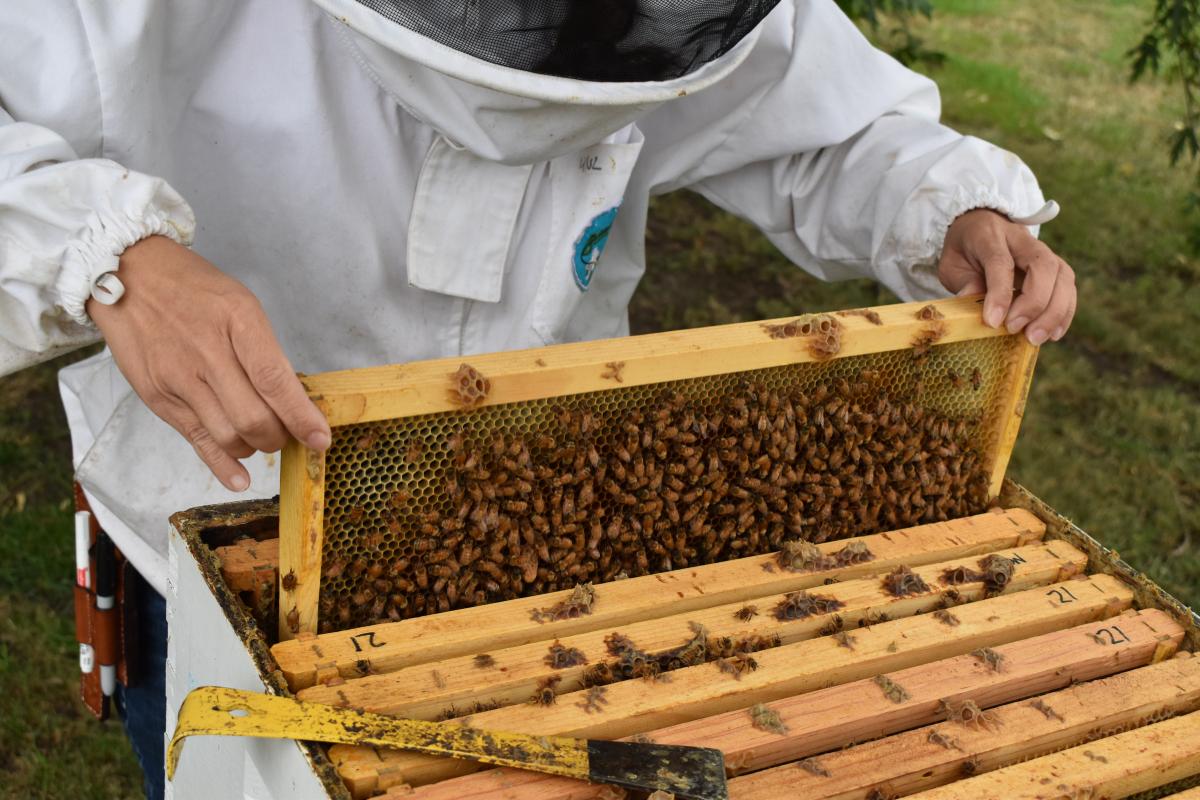
The Canary in the Coal Mine
Bees Help to Understand Pollution Impacts on Water, Soil, and Human Health
Exposure to high levels of pollution in the soil, water, and air is not only detrimental to the health of surrounding ecosystems, wildlife, and insects, but can also cause ramifications to human health.
Judy Wu-Smart, associate professor and Extension specialist in the Department of Entomology at the University of Nebraska–Lincoln, explores the harm pesticide pollution poses to bee health and through her research has uncovered even larger implications.
“Bees play an important role in the ability to inform us about the status of the environment,” Wu-Smart said. “We treat bees as biological indicators to help us promote and foster better conservation practices.”
Nebraska is an ecologically diverse state, and protecting its biodiversity from outside stressors, like pollution is important in order to preserve it for the future.
Bioindicators of Something Seriously Wrong
Bees are vital to ecosystem integrity, meaning bees are bioindicators and can be used to monitor change in ecosystem and environmental quality, according to Wu-Smart.
“Bees are highly sensitive to certain compounds,” Wu-Smart said. “That is why we call them bioindicators of the environment or ‘canaries in the coal mine.’ Bees can indicate issues with the environment typically before the issues reach human health.”
Through the research done to understand why the bee colonies were dying, Wu-Smart and her team pinpointed pollutants and work on ways to mitigate the problem.
“Beyond the loss of bees, there are potentially long-term ramifications at the ecological level that are critically important to consider with this type of pollution,” Wu-Smart said.
Understanding the Impacts
There are still many unknowns surrounding certain pollution impacts to the environment and human health, Wu-Smart said. However, looking at local ramifications, such as water pollution, helps researchers to understand and communicate future impacts.
For example, when there are persistent chemical loads in the soil, air, and water, Wu-Smart said, farmlands can develop chemical resistance, meaning that a pesticide no longer controls the insect or disease it was engineered to fight. Dead zones are also created in waterways, causing aquatic life to die due to low oxygen levels and lack of food or nutrients, and it is harder to support any kind of life or biodiversity.
However, there are still a number of unknown factors and health concerns for humans, other wildlife, and local communities that reside downstream where pollutants were released into the environment.
“We have to think about what it means to live in an area with chronic exposure to chemicals,” Wu-Smart said. “For instance, ‘What does it mean for children developing in areas where there are chemical loads in the air, water and plants?’ We are still working to determine these impacts.”
Even while the research is still being conducted, Wu-Smart said, we can only make assumptions based on potential impacts on soil and water health, as there is currently little information about human exposure and what that means in terms of health risks.
The AltEn Disaster
Since 2015, the AltEn corn ethanol plant, located in Mead, Neb., has been one of the largest stockpilers of excess seed corn in the United States. These piles of ethanol byproduct known as “wetcake” are rotting and causing health issues for local residents and wildlife.
In 2017, Wu-Smart started to notice many bees at the Eastern Nebraska Research and Extension Canter (ENREC) facility and around Mead were becoming sick and dying. After encountering this unusual trend, she dedicated her work to understanding how and why the bees were dying.
After years of research, Wu-Smart determined the residue of clothianidin, a pesticide commonly used to coat seeds, was found on milkweed plants, exceeding the level deemed safe by the Environmental Protection Agency (EPA) for food and water.
“The levels found were far exceeding what we had seen in previously published research with known application amounts,” Wu-Smart said. “That is when we realized that bees dying was potentially stemming from waterway contamination, rather than something that was happening on the fields.”
AltEn closed in February 2021, after the Nebraska Department of Environment and Energy issued an emergency order to cease operations at the plant after numerous environmental violations. Researchers are currently looking into how far and to what extent these contaminants from the plant have moved.
For more information on updated research, visit: https://entomology.unl.edu/faculty/dr-judy-wu-smart.
----------
Key Takeaways:
- Exposure to high levels of pollution in the soil, water, and air is detrimental to all kinds of life in Nebraska’s ecosystem.
- Nebraska is an ecologically diverse state and protecting its biodiversity from outside stressors like pollution is important in order to preserve it for the future.
- Bees are vital to ecosystem integrity and can be used to monitor change in ecosystem and environmental quality.
- Persistent chemical loads in the air, water, and soil can be very harmful to Nebraska’s farmland, water resources, and the health of humans in surrounding areas.
- For more information visit: https://entomology.unl.edu/faculty/dr-judy-wu-smart or https://www.unmc.edu/publichealth/departments/environmental/mead/.
